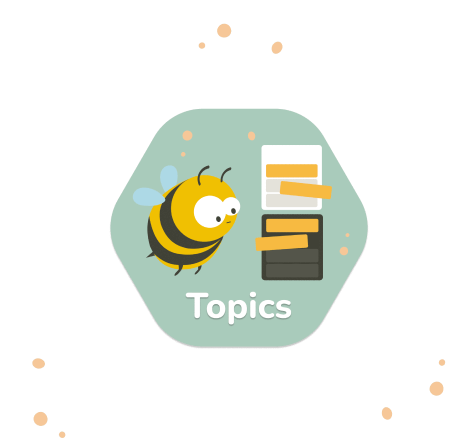Every digital product is filled with all manners of content – information – that it provides as value to its users. As a medium without content, the use of your product would be practically nonexistent.
Therefore, to make sure your product becomes a success, it’s important to optimize the content so that it makes sense to your future users. You conduct content testing to see how well the content performs its role when viewed by real users.
What is content testing?
Content testing is a research method used to validate the quality of your content and to find out whether it – the copywriting, the visuals, all the information – speaks to your target audience correctly and comprehensively.
Performed by people from all types of professional backgrounds, content testing helps marketers, content managers, UX designers and researchers determine if their representation of the content is intuitive to the intended users. Users should either already have the information they need to process the content, or the content should provide the right amount of intrinsic context to be understood from observation.
Why to test content?
The main objectives of content testing usually include:
- Highlighting and getting rid of confusing and unnecessary pieces of content
- Evaluating content’s readability
- Testing how well users understand what your content is about and the message behind it
- Evaluating the intuitiveness of navigation labels
- Getting rid of jargon and confusing wording
- Evaluating the tone of voice, the emotion and feeling that your content conveys
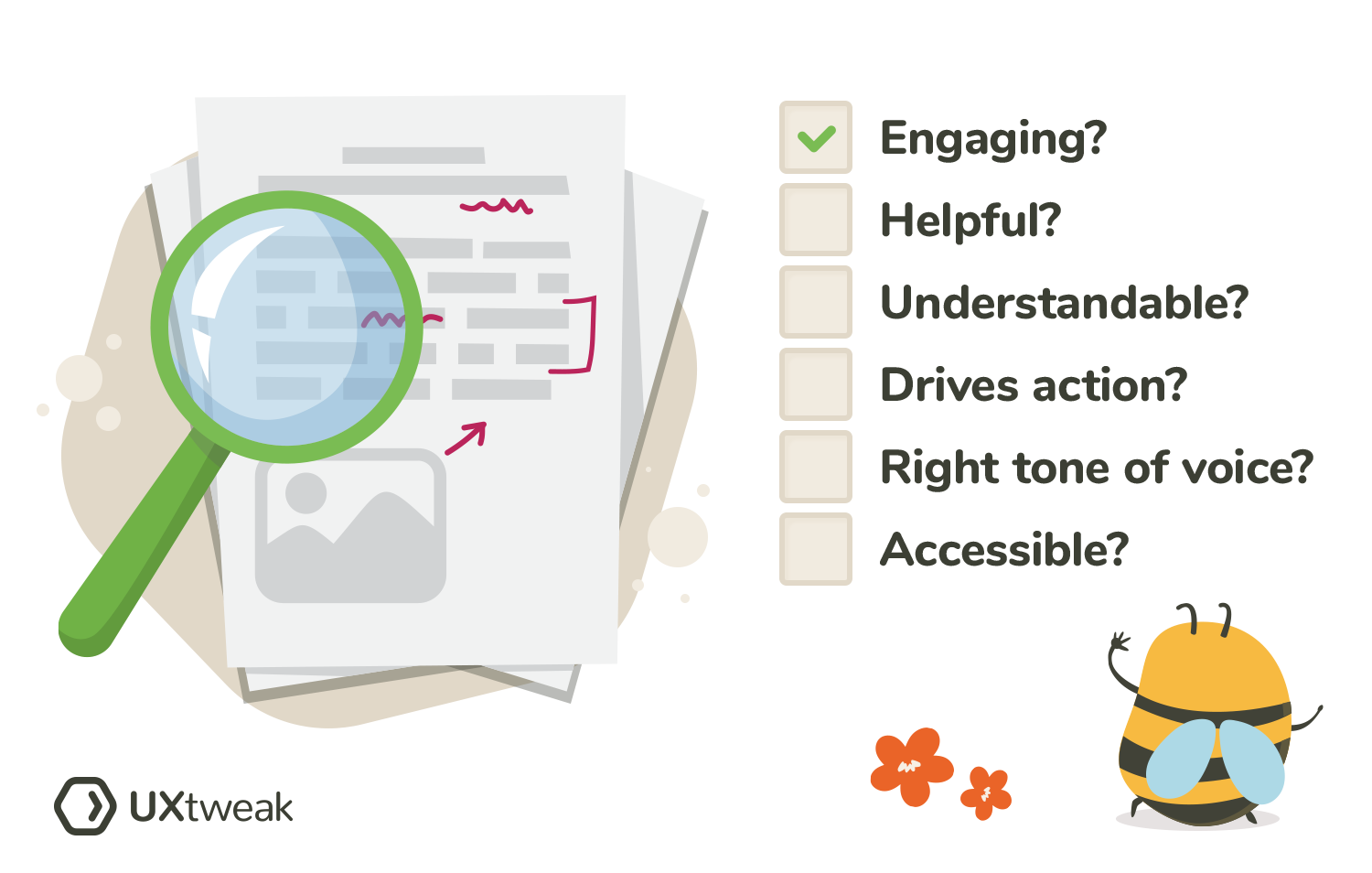
Content testing is important in order to make sure that your content resonates with your users. It sets the tone of your product overall the impression users have of your brand.
To create a successful product, it’s essential to make sure that your users can understand it and also that they themselves feel understood.
When to test content?
The thing with content testing your product is that you need to perform it in a manner that induces testers to have the right context, so they approach your content the same as in a real-life scenario. You can’t just ask users what they think about a menu label and expect the answers to be relevant without showing the context of where that label will be placed and what information can be found under it.
However, needing sufficient context doesn’t mean it should be a finished product yet either. You want to leave yourself a chance to improve and implement changes based on the insights from your content test.
That’s why we recommend performing several rounds of content testing during the design and development process.
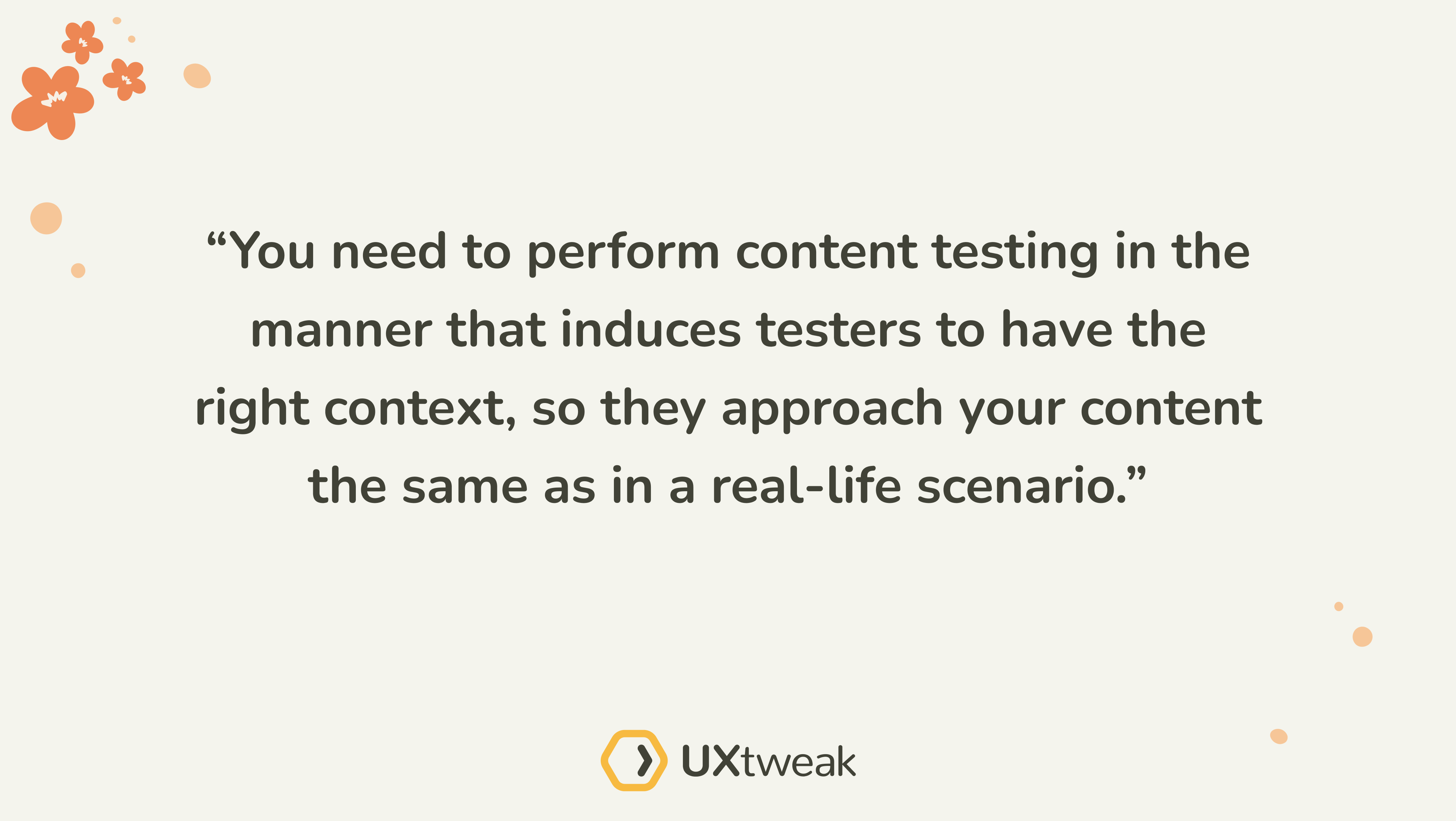
1.) Early stage: You can start at the early stages and use content testing to get a general overview of users’ expectations and the types of content you’re going to need.
2.) Prototype stage: Then, as you start creating a prototype, conduct concept testing to validate previous ideas and hypotheses. With this approach, you’ll still have time to make changes and improve your content without having to spend a lot of time and money on it.
3.) Before product launch: Before your product launches is a great time to conduct a final round of content testing to make sure all your content is perceived by users as it’s intended.
4.) After updates: Don’t forget to test your content after any significant updates or changes.
Ways to test content
There are several different criteria that you can evaluate through content testing. Let’s dive a bit deeper into their specifics and see what you can test your content for:
- Usability
- Readability
- Accessibility
- Searchability
- Tone of voice
Usability: refers to how easy your content is to interact with. How well your content speaks to the user, do they understand what you want them to do? This includes all types of content, from menu labels, their intuitiveness and ease of navigation, to how clear and engaging your CTAs are.
Readability: testing the readability of your content helps to understand how easy your content is to read and comprehend for the user. If they need to read a sentence or paragraph twice before they understand its meaning, this signifies poor content readability. Testing readability also helps to test the wording of your content, jargon and fonts you choose.
Searchability: refers to how easy it is for the user to find your content online. This point is closely connected with search engine optimization and your place at SERP.
Accessibility: accessibility measures how easily people with disabilities can use your product. Making your product accessible is important in order to make sure that as many people as possible can use it effectively. Testing content accessibility may include testing your video subtitles, fonts, color contrast and other.
Tone of voice: testing the tone of voice of your content assures that it resonates with the user, speaks to them in their language and conveys the right message. It also ensures consistency across various channels.
Content testing methods
There are a couple of different methods for content testing that you can use to find out what about your content works and what doesn’t.
Here are some of the most used ones:
- Usability Testing
- Five-second testing
- A/B testing
- Preference test
- Highlighter method
- Card sorting
- Cloze test
We talk about each of these methods in detail in a further section of this guide titled Content Testing Methods.
Content testing questions
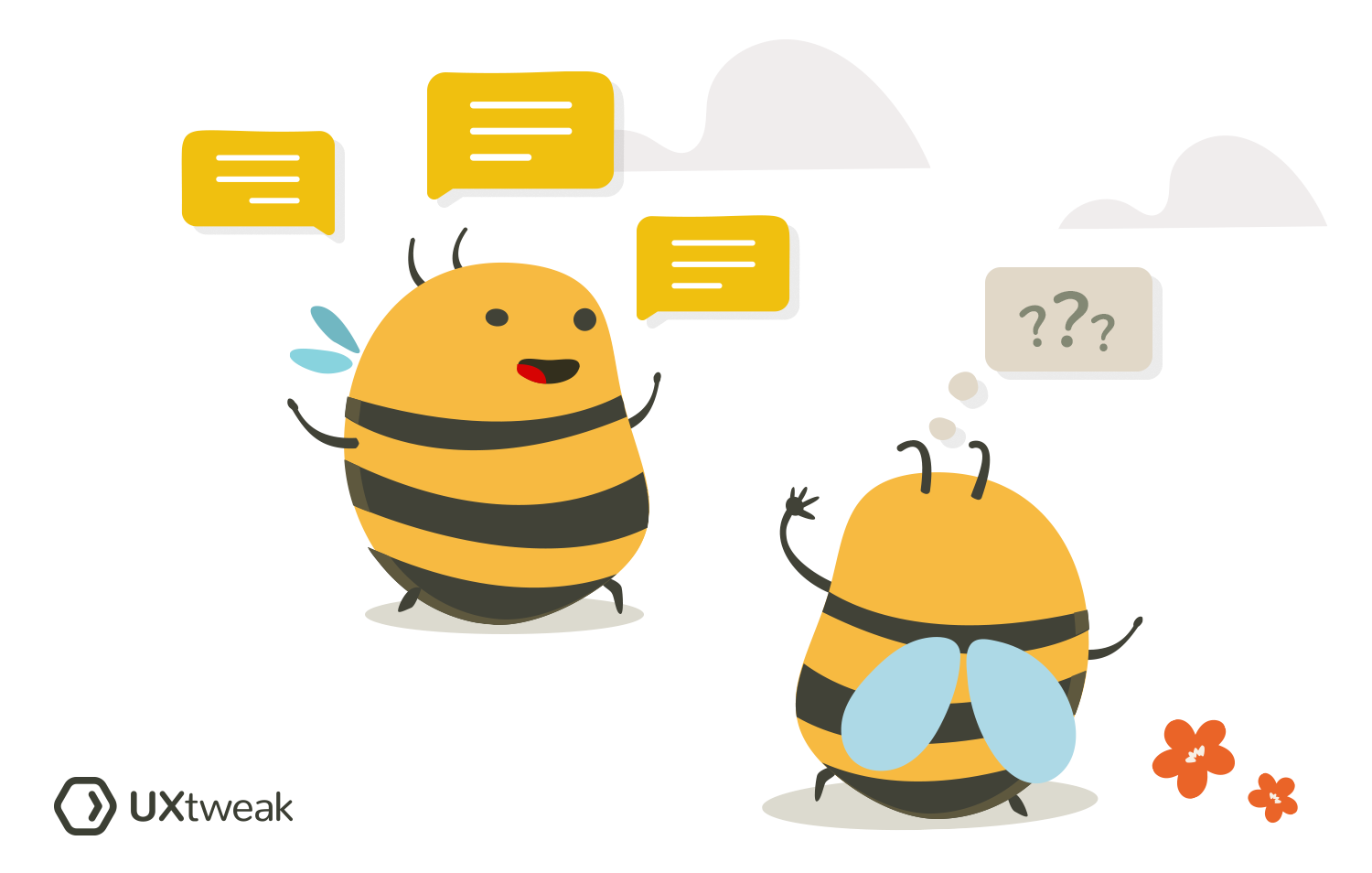
Coming up with the right questions for your content test is just as important as choosing the right participants for it. When writing questions for your study, consider the goals of your study and the type of content you’re testing.
Goal: Find out how the participants perceive the tone
Content testing questions to ask:
- Describe how this information made you feel in 3 or more words.
- Who do you think a typical customer of this brand may be? Describe them, what do they look like?
- Image what you just read is said by a person. What do they look like?
Goal: Find out how understandable the text is
Content testing questions to ask:
- Was it easy for you to understand the information, or was it somewhat difficult? Can you explain why?
- What is the main thing that you remember from what you’ve just read?
- What was the main topic of the text?
- Can you summarize what you’ve just read?
- Did you find the sentences easy to comprehend, or did you have to read them multiple times?
- Were there any terms that you didn’t understand?
Goal: Reveal if the text is engaging and driving next steps
Content testing questions to ask:
- Did you find the content interesting and engaging?
- Were you compelled to read or interact with the content further?
- Would you want to read more of this type of content?
- Would you share this content with a friend?
- Did the content make you want to take action (such as making a purchase, sharing on social media, etc.)?
How to test content
You can perform content testing by following these 5 easy steps:
- Define your goals
- Choose the content testing method
- Recruit the participants
- Conduct the study
- Analyze the results
Below we’ll take a closer look at each of the steps and explain them in detail.
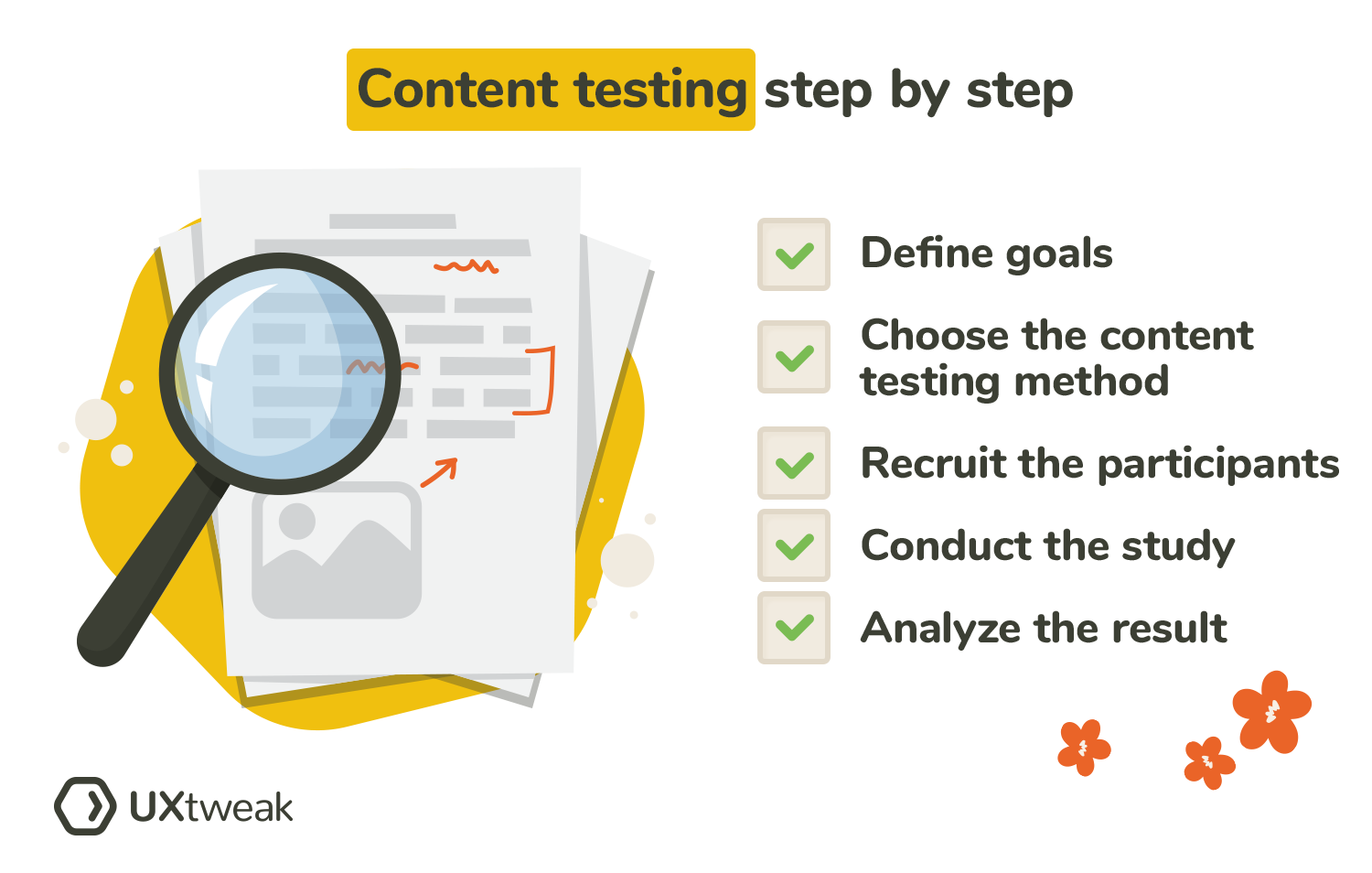
1. Define your goals
The first thing you need to do in order to set your content testing in the right direction is to decide on your goals.
What type of content do you want to test? What questions are you looking to find the answers to? Whom are you going to recruit as participants and why? Write all of this information down in clear statements so that you can come back to your goals at any time throughout the study when you need to make decisions.
Define a clear goal or two and focus on completing them with your future study. This type of approach will be very helpful later on, during the analysis of the results. It will also help you to focus on what’s important and not get carried away by non-essential details.
2. Choose the content testing method
The method you’ll choose for your content testing will depend on the goals of your study, the type of content you want to test as well as the time and budget available to you. There are at least 5 different content testing methods for you to choose from.
Check out the Content Testing Methods section of our guide to find the ones that work best for your current situation!
3. Recruit the participants
Recruiting the right participants for your research study is arguably the most challenging part of the task. But don’t worry, we’ve got you covered. UXtweak offers 2 different ways to facilitate recruiting of participants for your study: the Recruiting Widget, which turns your website visitors into testers, or the 160M+ User Panel. ⬇️
Remember to recruit people that represent your target audience and future or existing users. In case you are targeting several different groups of people, it’s a good practice to segment the study and recruit the respondents representative of all your target groups.
For more information check out our UX Research Recruiting 101 article.
4. Conduct the study
Choose whether you want to conduct your research with the help of a specialized content testing tool or by yourself. It’s also a major decision to determine if you are going to moderate your study. Moderated and Unmoderated tests both have their pros and cons, which you can find out more about in our Moderated vs. Unmoderated research comparison.
Before you start in earnest and go live, don’t forget to pilot your study on someone. Just ask a colleague, a friend or a family member. This will allow you to iron out easily preventable mistakes and avoid unnecessary confusion happening during the actual study.
Take a look at these tips and tricks to get the most out of your content testing session⬇️
5. Analyze the results
When data from all study participants has been collected, it’s your time to analyze the results and implement the insights. If you were using an online UX research tool to test your content, it will process most of the data for analysis for you.
Content testing best practices
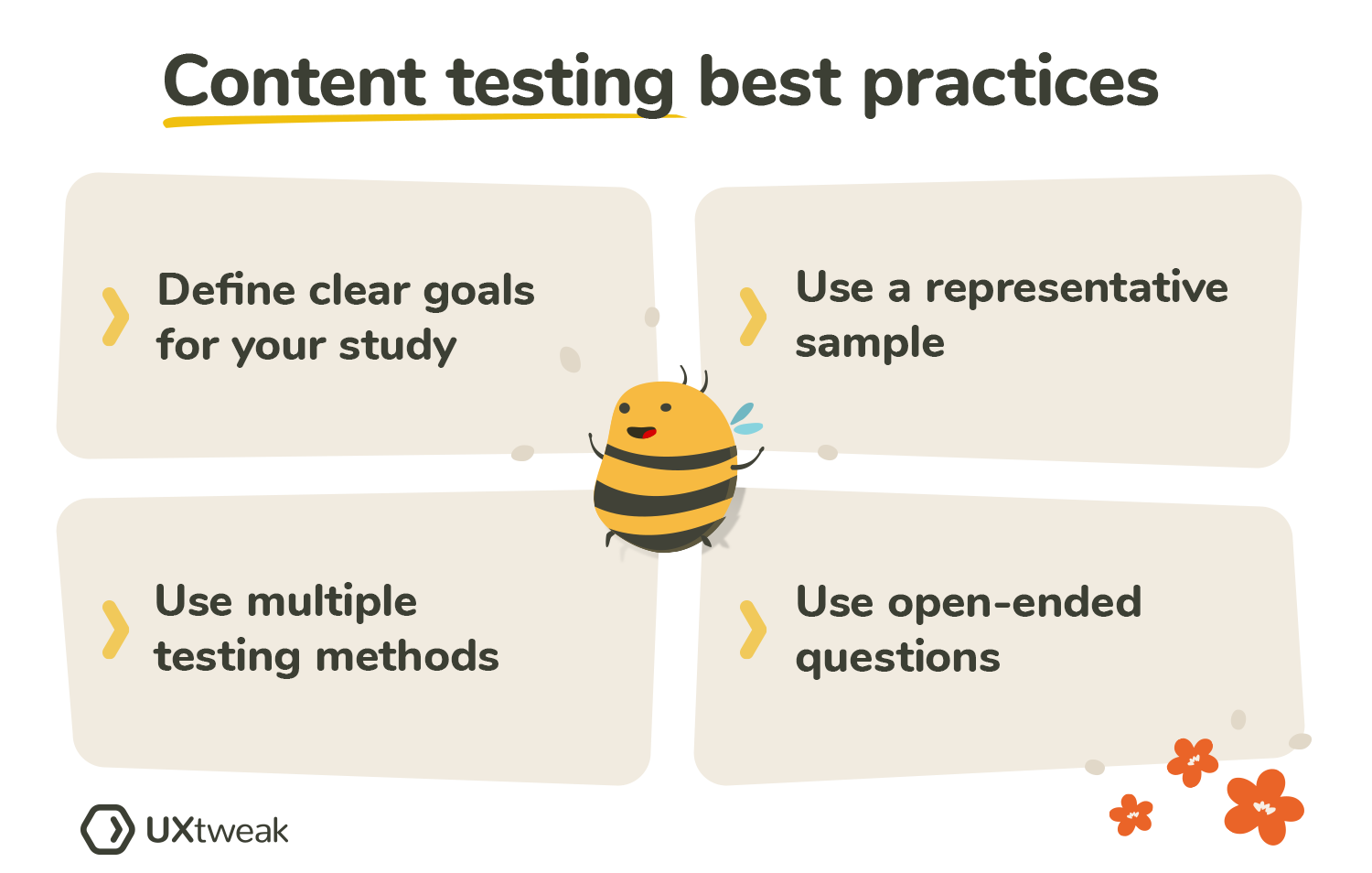
Define clear goals for your study
It’s essential to have a clear understanding of what you’re trying to achieve with your content testing. Identify what specific aspects of the content you want to test, and what data you’re hoping to gather.
We recommend to focus on testing one thing at a time, be it the readability of your content, its usability, accessibility, or tone of voice. This way you’ll be able to focus on gathering real insights, not just jumping from topic to topic.
Use a representative sample
Although, this is important when it comes to any type of testing with users, with content testing choosing the right respondents is directly connected to the success of your study. Your content needs to resonate with the ones who it was created for, so start by defining a clear picture of who your users are. This will give you a better idea of whom to recruit and what people are not relevant to your research.
If you’re conducting your research online, consider including a screening question to filter out those irrelevant participants and assure the accuracy of the results. Below, we’ll explain how you can aim to recruit the most representative sample for your study and where to look for those people.
Use multiple testing methods
Using different content testing methods (such as A/B testing, usability testing, and surveys) can help you get a better understanding of how your content performs and what it lacks. A great tip is to combine qualitative and quantitative research methods together for deeper insights.
For example, you can conduct a usability test to gather qualitative data and a card sorting exercise for more numerical insights and a better understanding of your users’ mental models.
When you know your product is similar to a product of a competitor you can compare your content (such as product description or instruction) with a preference test. That way you can test if your content is more understandable and helpful.
Read more about Mixed Method Research.
Use open-ended questions
Use open-ended tasks that make the participant think. Don’t just ask them to read a piece of text and express their opinion of it. Although this type of content testing also has its merit, often you want to evaluate the content in a larger context.
To evaluate a paragraph of text on a website, for example, you also want to see how easy it is for the respondent to find and how clear the navigation labels are. An open-ended task could be something along the lines of “You are looking for this information and our website. Please, try to figure out where you would find it.”
Then you can observe the participant as they progress through the task, and afterward, ask follow-up questions, such as: “How difficult was it to complete the task?” or “Did you understand what the text was saying?”.
How to find content testing participants?
Finding the right participants for your study is especially important when it comes to content testing. Your primary goal here is to ensure that your content resonates with your target audience. If you choose the wrong participants for your content test, your results may not accurately reflect how your target audience will respond to your content.
For example, if you’re testing content aimed at teenagers, it’s important to use a sample that includes a significant number of teenagers to ensure that your results are representative of that audience. If you test your content with a group of middle-aged adults, your results may not accurately reflect how teenagers will respond to your content.
Therefore, make sure to take your time and recruit a representative testing sample for your content test. There are several ways to do that.
1. Recruit from your real users
The easiest way to ensure that your test participants are representative of your target audience is to recruit people that are already your users. If you have a website that people occasionally visit, all you need to do is add an Onsite Recruiting Widget to it.
This feature will help to easily transform your real users into testers and usually for free! When your website visitors come to a specific page they will see a widget that offers them to participate in a research study for a small incentive. This can be a discount code, a gift card or whatever else that is valuable to your users.
This is the ultimate way to get participants for your content testing study with little to no budget!
2. Recruit from user panels
Another way to get a specific target group for your content tests is to recruit them from specialized User Panels. Many online content testing tools offer access to extensive pools of participants with tons of criteria to choose from. This allows you to recruit a specific target group without having to invest tons of money when doing it through a recruiting agency.



